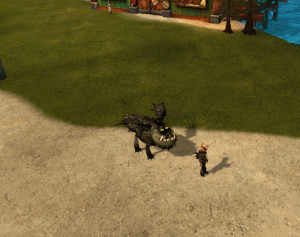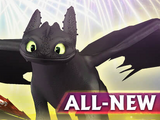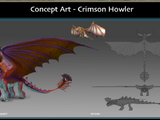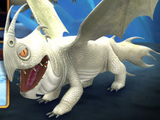Dragons are a primary mechanic in School of Dragons. Each player begins the game by recieving a randomized secondary starter and then proceed with choosing their primary starter; from there each player can continue on to obtain other dragons, either through spending coins or gems, by completing Stable Missions, or by earning certain dragons through the completion of quests.

The level up effect (dragon animation isn't included)
Dragons have five stages: Egg, Tinytooth (baby), Shortwing (teen), Broadwing (adult) and Titanwing (titan). With the exception of the Gronckle, Hideous Zippleback, Deadly Nadder, and Monstrous Nightmare, all eggs save that of your starter dragon take twelve hours to hatch. Incubating eggs have a Hatch Now option which allows a player to spend gems to hatch their egg right away. The cost varies by the species of the egg despite the fact that almost all eggs take the same amount of time to hatch. Additionally, the Hatch Now cost does not decrease as the egg gets closer to its default hatching time.
When your dragon reaches the Shortwing stage (levels 5-9), you can mount and glide with your dragon. In the Broadwing stage (level 10 and beyond), your dragon can be mounted and flown. When mounted on your dragon, you are capable of shooting fireballs at fire pits and ships in the battle events. For more information on how to glide and fly, see the Flying & Gliding page.
To make your dragon grow to teen and adult stages, you need to go to the Dragon Hearth in The Hatchery when the dragon reaches level 5 (for teen) or level 10 (for adult).
Update 1.19 on April 20th, 2016 introduced the Titan stage. Titan dragons have a higher energy level, and higher fire damage. Dragons need to be at level 20 or higher to become Titans. For the transformation, you need to collect 50 Runes (through dedicated Stable Missions), and to the new Titan Island. There are currently over 10+ dragons with Titan Stage.
Update 2.13 on August 8th, 2018 introduced the ability to use your own dragons in Dragon Tactics, introducing six new stats and multiple moves for each dragon to use in battle. In order for your dragon to participate in the Tactics, the dragon has to be and adult or titan, have enough energy and not be in a Stable Mission. If the dragon's species isn't one of the 0 allowed species, then your dragon can't be used in Tactics, no matter what. The update also increased the level cap from 30 to 50.
Update v3.0.0 of February 21st, 2019 now includes the Dragon Bonding XP progress in Dragon Tactics, to check how much each level require, check the Dragon Bonding XP page.
Each dragon has an energy bar and a happiness bar. As a dragon levels up, its maximum energy increases. All dragons have a happiness bar of 100 that does not change as it levels. A dragon's happiness will gradually go down as you play and shooting fireballs will expedite that process. A dragon's happiness will never reach zero, only one. An unhappy dragon will walk slower, fly slower, and can not glide as far as a happy one, in addition to not being able to shoot fireballs. Energy, however, will gradually increase over time. Collecting nearby items, completing tasks, and playing minigames will decrease a dragon's energy; when its energy is depleted, it can no longer do any of these tasks.
To increase a dragon's energy ![]() , feed it fish or chicken eggs. To increase a dragon's happiness
, feed it fish or chicken eggs. To increase a dragon's happiness ![]() , play with it or feed it certain species of fish. Note that eels will neither give your dragon energy or happiness--in fact, they will decrease your dragon's happiness--though they will provide experience. The only exception to this are Typhoomerangs, Death Songs, and Slithersongs, which will gain energy from eating eels.
, play with it or feed it certain species of fish. Note that eels will neither give your dragon energy or happiness--in fact, they will decrease your dragon's happiness--though they will provide experience. The only exception to this are Typhoomerangs, Death Songs, and Slithersongs, which will gain energy from eating eels.
History
- 8/8/13, version 2.0: Energy regeneration rates were balanced.
- 9/12/13 version 4.0: Feed menu changed to not close after each fish fed to a dragon.
- 9/27/13 version 4.2: Issues with not being able to repeatedly feed fish in the pet feed menu fixed.
Each dragon species has five primary stats that help set it apart from other species. The stats are all rank from one to ten, with ten being the strongest and one being the weakest. The Fireworm Queen is the only dragon that has a stat greater than 10. Occasionally School of Dragons updates the stats of a given species. Notable examples of this include the Hideous Zippleback, the Snow Wraith, and the Screaming Death.
In Update 2.13, the stats are now divided in two groups: Combat stats and Racing stats.
Racing Stats are the stats that demonstrate how fast your dragon is, each species have their own measures, which ranges from a 1 to a 10, however don't be bummed if your dragon's species' stats is "bad", just because its stats are very low/mid, it doesn't mean they can't beat dragons like the Night Fury in a race. The racing stats include:
- Max Speed
 : This determines your dragon's speed in Flight Club, Thunder Run Racing, and normal gameplay.
: This determines your dragon's speed in Flight Club, Thunder Run Racing, and normal gameplay. - Pitch Rate
 : This determines how quickly a dragon can ascend and descend.
: This determines how quickly a dragon can ascend and descend. - Turn Rate
 : This shows how agile your dragon is and how tightly it can make turns.
: This shows how agile your dragon is and how tightly it can make turns. - Acceleration
 : This measures how quickly your dragon can reach its maximum speed.
: This measures how quickly your dragon can reach its maximum speed. - Firepower
 : The meaning of this stat is currently unknown; the number of shots vary per dragon but there appears to be no correlation between shot limit, damage per hit, and fire power. As an example, the Fireworm Queen has 10.3 fire power, 6 shots, 15 base damage per shot, and 672 HP at level 20. A Thunderdrum also has 6 shots and 15 base damage, has 685 HP at level 20, and yet only has a fire power of 8.3.
: The meaning of this stat is currently unknown; the number of shots vary per dragon but there appears to be no correlation between shot limit, damage per hit, and fire power. As an example, the Fireworm Queen has 10.3 fire power, 6 shots, 15 base damage per shot, and 672 HP at level 20. A Thunderdrum also has 6 shots and 15 base damage, has 685 HP at level 20, and yet only has a fire power of 8.3.
Combat Stats are stats that determine how strong your dragon is, each dragon species also have their own stats and moves but unlike racing stats that can only be increased with saddles albeit slightly, the stats increase level by level until it hits the level cap. Said combat stats include:
- Attackpower
 : Shorten as ATK, this determines how physically strong your dragon is;
: Shorten as ATK, this determines how physically strong your dragon is; - Firepower
 : Shorten as FPR, this determines how strong your dragon's ranged/breath attacks are;
: Shorten as FPR, this determines how strong your dragon's ranged/breath attacks are; - Movement
 : Shorten as MOVE, this determinss how far can your dragon move in one turn;
: Shorten as MOVE, this determinss how far can your dragon move in one turn; - Critical Chance
 : Shorten as CRIT, this determines the chance of your dragon inflict critical damage, which does double of the normal damage;
: Shorten as CRIT, this determines the chance of your dragon inflict critical damage, which does double of the normal damage; - Healpower
 : Shorten as HPR, this determines how much does the dragon heals itself or other characters*;
: Shorten as HPR, this determines how much does the dragon heals itself or other characters*; - Defense
 : Shorten as DEF, this determines the chance of the dragon to dodge any incoming attacks;
: Shorten as DEF, this determines the chance of the dragon to dodge any incoming attacks;
While attack power and fire power look and souns almost the exact same, the major difference is that fire power refers to the melee attacks while attack power refers to the ranged attacks. This is essentially why the Hideous Zippleback at lvl11 has a higher fire power than attack while the Speed Stinger has a higher attack than fire power.
- * - Note that not all the species have a healing move like how the Whispering Death and Triple Stryke have, therefore, the healing power may refer to how much it would heal if it had one.
While the firepower belongs to battle than racing, the racing stats also give a general idea of how fast can your dragon go from the recovery stations to the ship. Other battle stats or secondary stats include:
- Battle Health: ** This is how much health your dragon has. Use only in battle events, HP is inversely proportional to how many players are participating in said event.
- HP regeneration: How much and how fast your dragon recovers HP without the need to visit a Recovery Camp.
- Firing speed: After firing a shot, every dragon has a cool-down period during which they can't fire. This stat determines how many seconds that cool-down lasts for
- Fire recharge speed: Dragons recover shots over time, even without the use of a Recovery Camp. This stat determines how many seconds it takes to recover one shot.
- Critical hit chance: This stat determines the odds for each species to land a critical hit, which does two times a species base damage.
- Firing range: This stat effects how near or far a dragon of a given species needs to be to a target before the firing reticle will appear. While not official, where's a general measurement of each species range.
- ** - Battle Health is the green bar located on the top left UI, is often confused to be the Viking's Health due to its placement, and it increases with the Dragon's level. It should be noted Vikings with the game created before March 12th, 2018 (release of Wrath of Stormheart) and are under Level 35 will influence the Dragon's Battle Health and increase it with the Viking's level as opposed to the Dragon's level. So when gathering the Battle Health, it's safer if your Viking is Level 35 or higher as it won't influence the Dragon's Battle Health.
-

Sand Wraith -

Light Fury -

Night Fury -

Chimeragon -

Crimson Howler -

Night Light -

Night Terror -

Gruesome Goregripper
All items (113)
- Sand Wraith
- Sandbuster
- Scauldron
- Screaming Death
- Scuttleclaw
- Seashocker
- Seastormer
-
Category:Secondary Starter Dragons
- Sentinel
-
Category:Sharp Class
- Shivertooth
- Shockjaw
- Shovelhelm
- Silver Phantom
- Singetail
- Skrill
- Skrillknapper
- Sliquifier
- Slithersong
- Slitherwing
- Smothering Smokebreath
- Snafflefang
- Snaptrapper
- Snow Wraith
- Songwing
- Speed Stinger
-
Category:Stoker Class
- Stormcutter
-
Category:Strike Class
- Sweet Death


























































































